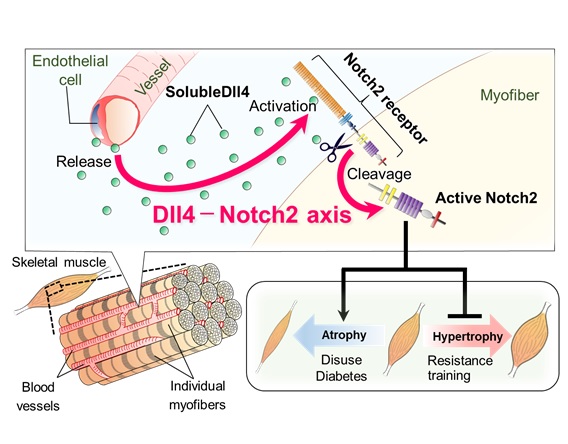
Authors: Shin Fujimaki, Tomohiro Matsumoto, Masashi Muramatsu, Hiroshi Nagahisa, Naoki Horii, Daiki Seko, Shinya Masuda, Xuerui Wang, Yoko Asakura, Yukie Takahashi, Yuta Miyamoto, Shingo Usuki, Kei-ichiro Yasunaga, Yasutomi Kamei, Ryuichi Nishinakamura, Takashi Minami, Takaichi Fukuda, Atsushi Asakura, Yusuke Ono
Title: The endothelial Dll4−muscular Notch2 axis regulates skeletal muscle mass
Journal: Nature Metabolism.
DOI: 10.1038/s42255-022-00533-9.
Adult skeletal muscle is a highly plastic tissue that readily reduces or gains its mass in response to mechanical and metabolic stimulation; however, the upstream mechanisms that control muscle mass remain unclear. Notch signaling is highly conserved, and regulates many cellular events, including proliferation and differentiation of various types of tissue stem cells via cell–cell contact. Here we reveal that multinucleated myofibers express Notch2, which plays a crucial role in disuse- or diabetes-induced muscle atrophy. Mechanistically, in both atrophic conditions, the microvascular endothelium upregulates and releases the Notch ligand, Dll4, which then activates muscular Notch2 without direct cell–cell contact. Inhibition of the Dll4–Notch2 axis substantively prevents these muscle atrophy and promotes mechanical overloading-induced muscle hypertrophy in mice. Our findings demonstrate for the first time that the endothelial Dll4–muscular Notch2 axis represents a novel and attractive target to treat muscle wasting diseases. Our results also highlight a unique aspect of Notch signaling whereby EC-derived soluble form of Dll4 is able to activate the muscular Notch2 without direct cell–cell contact, suggesting that tissue-specific endothelial cells may exert tissue-specific functions in tissue homeostasis and pathogenesis throughout the body.

Schematic of the findings: Identification of the endothelial Dll4- muscular Notch2 axis.